Thermal Printer Market: Current Analysis and Forecast (2024-2032)
$3999 – $6999
Emphasis on Printer Technology (Direct Thermal Printer, Thermal Transfer Printer, and Dye Diffusion Thermal Transfer); Industry (Transportation and Logistics, BFSI, Healthcare, Food Service, Retail, and Other); Printer Type (Barcode Printer, POS Printer, Kiosk & Ticket Printer, RFID Printer, and Card Printer); Region/Country.
| Pages: | 104 |
|---|---|
| Table: | 71 |
| Figure: | 62 |
| Report ID: | UMSE212868 |
| Geography: |

Report Description
Thermal Printer Size & Forecast
The Thermal Printer Market was valued at USD 4.1 billion in 2023 and is expected to grow at a robust CAGR of around 4.8% during the forecast period (2024-2032) owing to the rising adoption of thermal Printers in the Packaging and Commercial Industries.
Thermal Printer Analysis
The Thermal Printer Market is experiencing significant growth globally, driven by several key factors. One of the primary drivers is the increasing adoption of mobile and wireless printing solutions across various industries. With the rise of mobile devices and the need for on-the-go printing capabilities, there is a growing demand for thermal printers that can seamlessly integrate with smartphones, tablets, and other mobile devices. This trend is particularly evident in sectors such as retail, logistics, and healthcare, where efficient printing of labels, receipts, and other documents is essential for operations.
Another driver of growth in the Thermal Printer Market is the push towards eco-friendly and sustainable printing solutions. As businesses become more environmentally conscious, there is a rising demand for thermal printers that use eco-friendly materials and consume less energy. Manufacturers are responding to this demand by developing thermal printers that are energy-efficient, use recyclable materials, and produce minimal waste. This focus on sustainability is not only driven by environmental concerns but also by cost savings and regulatory requirements.
Furthermore, The Thermal Printer Market is benefiting from the increasing emphasis on supply chain efficiency and traceability. In industries such as logistics, manufacturing, and retail, there is a growing need for printers that can produce high-quality, durable labels for tracking products throughout the supply chain. Thermal printers are well-suited for this purpose due to their ability to produce crisp, clear prints that are resistant to smudging and fading. As companies seek to improve their supply chain visibility and efficiency, the demand for thermal printers is expected to continue to rise.
Thermal Printer Trends
This section discusses the key market trends that are influencing the various segments of the Thermal Printer as identified by our team of research experts.
Government Policies Supporting the Thermal Printer Industry
Government policies can have a significant impact on the thermal printer industry, influencing market growth, innovation, and sustainability. Some of the keyways in which government policies can support the thermal printer industry include:
Technology Development Incentives: Governments can offer tax incentives, grants, or subsidies to encourage research and development (R&D) in thermal printing technology. This can help drive innovation and the development of more advanced and efficient thermal printers.
Environmental Regulations: Governments can implement regulations and standards aimed at reducing the environmental impact of printing technology. This can include requirements for energy-efficient printers, restrictions on harmful chemicals in printing materials, and incentives for recycling printer components.
Trade Policies: Government trade policies can influence the import and export of thermal printers and related components. Tariffs, trade agreements, and export incentives can affect the competitiveness of thermal printer manufacturers in global markets.
Industry Standards and Certification: Governments can establish industry standards and certification requirements for thermal printers. Compliance with these standards can help ensure product quality, safety, and interoperability.
Support for Small and Medium Enterprises (SMEs): Governments can provide support programs specifically targeted at SMEs in the thermal printer industry. This can include access to funding, training programs, and assistance with market entry and expansion.
Promotion of Digitalization and Automation: Governments can promote the digitalization and automation of industries that rely on thermal printers, such as retail and logistics. This can create a larger market for thermal printers and drive demand for more advanced printing solutions.
By implementing supportive policies, governments can help stimulate growth and innovation in the thermal printer industry, leading to benefits for manufacturers, consumers, and the environment.
APAC is Expected to Grow with Significant CAGR During Forecast Period
The Thermal Printer Market in the Asia-Pacific (APAC) region is experiencing robust growth, driven by several key factors. One of the primary drivers is the rapid industrialization and urbanization occurring across the region. Countries like China, India, and Southeast Asian nations are witnessing significant industrial growth, which in turn boosts the demand for efficient printing solutions in the manufacturing, logistics, and retail sectors. Thermal printers are increasingly being adopted for labeling, inventory management, and product tracking, facilitating smoother and more efficient operations in these burgeoning industries. Another major driver is the exponential growth of the e-commerce sector in the APAC region. With the surge in online shopping, there is a corresponding increase in the need for reliable and high-speed printing solutions for order fulfillment and delivery processes. Thermal printers play a crucial role in printing shipping labels, receipts, and barcodes, which are essential for managing large volumes of orders and ensuring timely delivery. The convenience and efficiency offered by thermal printers make them indispensable tools for e-commerce businesses looking to streamline their operations.
Thermal Printer Industry Overview
The Thermal Printer Market is competitive and fragmented, with the presence of several global and international market players. The key players are adopting different growth strategies to enhance their market presence, such as partnerships, agreements, collaborations, new product launches, geographical expansions, and mergers and acquisitions. Some of the major players operating in the market are Honeywell International Inc., Advantech Co., Ltd., Zebra Technologies Corporation, Fujitsu Limited, HP Development Company, L.P., Seiko Epson Corporation, Toshiba Tec Corporation, Brother Industries, Ltd., Star Micronics Co., Ltd., and NEC Corporation.
Thermal Printer News
In February 2024, ROHM Semiconductor introduced the KR2002-Q06N5AA thermal printhead, compatible with single Li-ion battery cell (3.6V) battery drive that achieves high performance printing while improving energy savings by approximately 30%.
In January 2024, HP Inc. announced the official launch of its HP Thermal Inkjet (TIJ) 108mm Bulk Printing Solution, the latest advancement to its world-renowned TIJ 4.0 Printhead technology, disrupting industry packaging processes. Boasting high speed, high resolution, and longer throw distances up to 10mm, the HP 108mm Printhead is now available to support customers globally with various wide-swath high-volume printing applications without stitching.
Thermal Printer Report Coverage
Reasons to buy this report:
- The study includes market sizing and forecasting analysis validated by authenticated key industry experts.
- The report presents a quick review of overall industry performance at one glance.
- The report covers an in-depth analysis of prominent industry peers with a primary focus on key business financials, product portfolios, expansion strategies, and recent developments.
- Detailed examination of drivers, restraints, key trends, and opportunities prevailing in the industry.
- The study comprehensively covers the market across different segments.
- Deep dive regional level analysis of the industry.
Customization Options:
The Global Thermal Printer can further be customized as per the requirement or any other market segment. Besides this, UMI understands that you may have your own business needs, hence feel free to contact us to get a report that completely suits your requirements.
Frequently Asked Questions (FAQ)
Q1: What is the current market size and growth potential of the Thermal Printer market?
Ans: The Thermal Printer was valued at USD 4.1 Billion in 2023 and is expected to grow at a CAGR of 4.8% during the forecast period (2024-2032).
Q2: What are the driving factors for the growth of the Thermal Printer market?
Ans: Rapid industrialization and technological advancements are the primary drivers of the thermal printer market's growth.
Q3: Which segment has the largest share in the Thermal Printer market by Printer Type?
Ans: The Barcode Printer segment has the largest share of the Thermal Printer by Printer Type.
Q4: What are the emerging technologies and trends in the Thermal Printer market?
Ans: Emerging trends in the thermal printer market include mobile printing, IoT integration, cloud services, RFID printing, sustainability, enhanced connectivity, improved print quality and speed, and customization capabilities.
Q5: Which region will dominate in the Thermal Printer market?
Ans: APAC is expected to dominate the market during the forecast period.

You can also purchase parts of this report. Do you want to check out a section wise
price list?
Research Methodology
Research Methodology for the Thermal Printer Analysis (2024-2032)
Analyzing the historical market, estimating the current market, and forecasting the future market of global Thermal Printer were the three major steps undertaken to create and explore the adoption of Thermal Printer in major regions globally. Exhaustive secondary research was conducted to collect the historical market numbers and estimate the current market size. Secondly, numerous findings and assumptions were taken into consideration to validate these insights. Moreover, exhaustive primary interviews were also conducted with industry experts across the value chain of the global Thermal Printer. Post assumption and validation of market numbers through primary interviews, we employed a top-down/bottom-up approach to forecasting the complete market size. Thereafter, market breakdown and data triangulation methods were adopted to estimate and analyze the market size of segments and sub-segments of the industry. Detailed methodology is explained below:
Analysis of Historical Market Size
Step 1: In-Depth Study of Secondary Sources:
A detailed secondary study was conducted to obtain the historical market size of the Thermal Printer through company internal sources such as annual reports & financial statements, performance presentations, press releases, etc., and external sources including journals, news & articles, government publications, competitor publications, sector reports, third-party database, and other credible publications.
Step 2: Market Segmentation:
After obtaining the historical market size of Thermal Printer, we conducted a detailed secondary analysis to gather historical market insights and share for different segments and sub-segments for major regions. Major segments are included in the report such as Printer Technology, Industry, and Printer Type. Further country-level analyses were conducted to evaluate the overall adoption of testing models in that region.
Step 3: Factor Analysis:
After acquiring the historical market size of different segments and sub-segments, we conducted a detailed factor analysis to estimate the current market size of the Thermal Printer. Further, we conducted factor analysis using dependent and independent variables such as Printer Technology, Industry, and Printer Type of the Thermal Printer. A thorough analysis was conducted of demand and supply-side scenarios considering top partnerships, mergers and acquisitions, business expansion, and product launches in the Thermal Printer sector across the globe.
Current Market Size Estimate & Forecast
Current Market Sizing: Based on actionable insights from the above 3 steps, we arrived at the current market size, key players in the global Thermal Printer, and market shares of the segments. All the required percentage shares split, and market breakdowns were determined using the above-mentioned secondary approach and were verified through primary interviews.
Estimation & Forecasting: For market estimation and forecast, weights were assigned to different factors including drivers & trends, restraints, and opportunities available for the stakeholders. After analyzing these factors, relevant forecasting techniques i.e., the top-down/bottom-up approach were applied to arrive at the market forecast for 2032 for different segments and sub-segments across the major markets globally. The research methodology adopted to estimate the market size encompasses:
- The industry’s market size, in terms of revenue (USD) and the adoption rate of the Thermal Printer across the major markets domestically
- All percentage shares, splits, and breakdowns of market segments and sub-segments
- Key players in the global Thermal Printer in terms of products offered. Also, the growth strategies adopted by these players to compete in the fast-growing market
Market Size and Share Validation
Primary Research: In-depth interviews were conducted with the Key Opinion Leaders (KOLs) including Top Level Executives (CXO/VPs, Sales Head, Marketing Head, Operational Head, Regional Head, Country Head, etc.) across major regions. Primary research findings were then summarized, and statistical analysis was performed to prove the stated hypothesis. Inputs from primary research were consolidated with secondary findings, hence turning information into actionable insights.
Split of Primary Participants in Different Regions
Market Engineering
The data triangulation technique was employed to complete the overall market estimation and to arrive at precise statistical numbers for each segment and sub-segment of the global Thermal Printer. Data was split into several segments & sub-segments post studying various parameters and trends in the areas of Printer Technology, Industry, and Printer Type in the global Thermal Printer.
The main objective of the Global Thermal Printer Study
The current & future market trends of the global Thermal Printer were pinpointed in the study. Investors can gain strategic insights to base their discretion for investments on the qualitative and quantitative analysis performed in the study. Current and future market trends determined the overall attractiveness of the market at a regional level, providing a platform for the industrial participant to exploit the untapped market to benefit from a first-mover advantage. Other quantitative goals of the studies include:
- Analyze the current and forecast market size of the Thermal Printer in terms of value (USD). Also, analyze the current and forecast market size of different segments and sub-segments
- Segments in the study include areas of Printer Technology, Industry, and Printer Type
- Define and analysis of the regulatory framework for the Thermal Printer industry
- Analyze the value chain involved with the presence of various intermediaries, along with analyzing customer and competitor behaviors of the industry
- Analyze the current and forecast market size of the Thermal Printer for the major region
- Major countries of regions studied in the report include Asia Pacific, Europe, North America, and the Rest of the World
- Company profiles of the Thermal Printer and the growth strategies adopted by the market players to sustain in the fast-growing market
- Deep dive regional level analysis of the industry

You can also purchase parts of this report. Do you want to check out a section wise
price list?
You must be logged in to post a review.

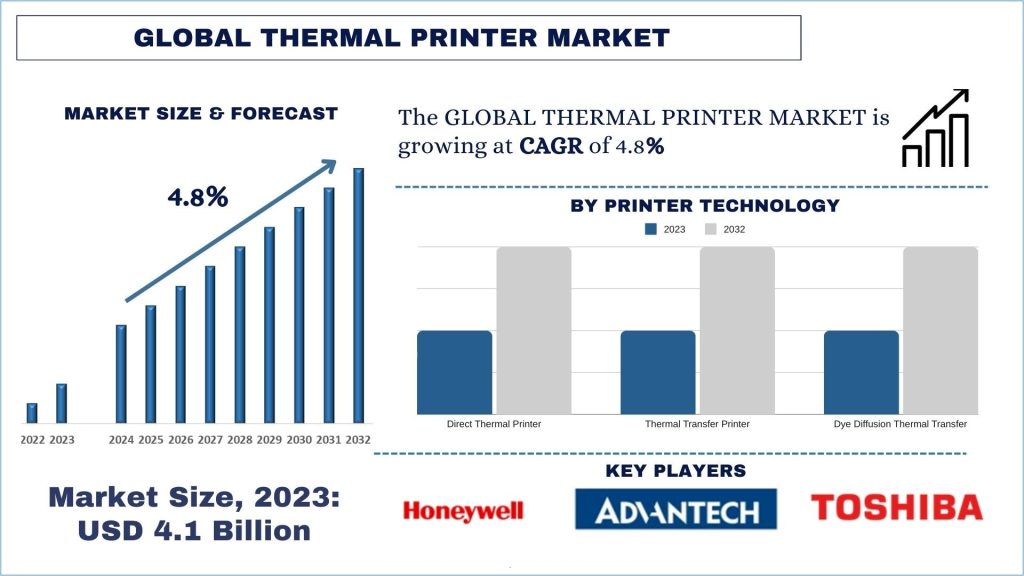
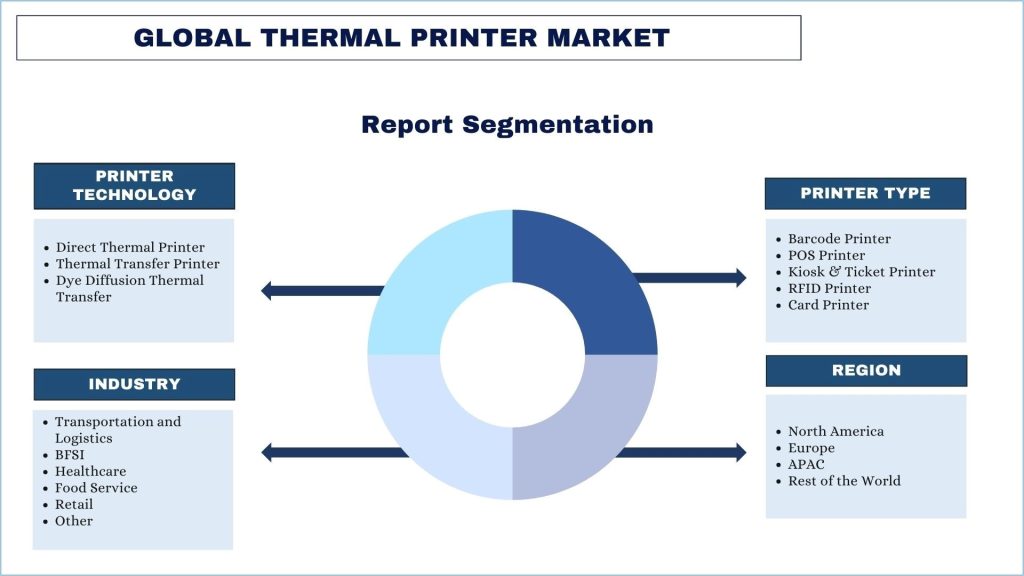
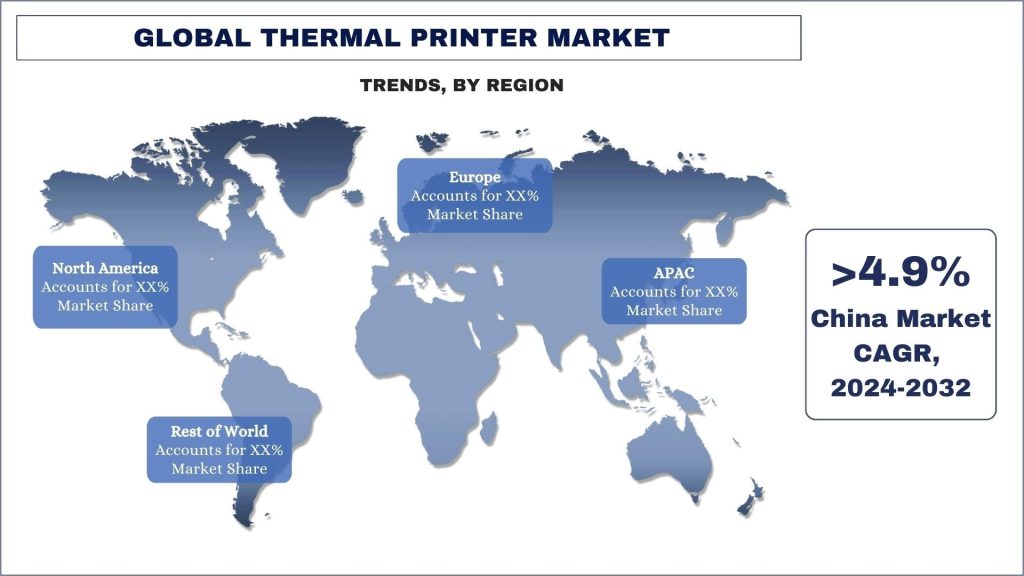
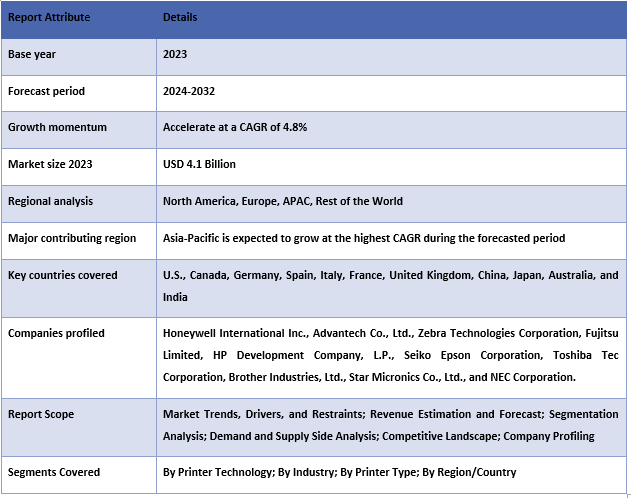
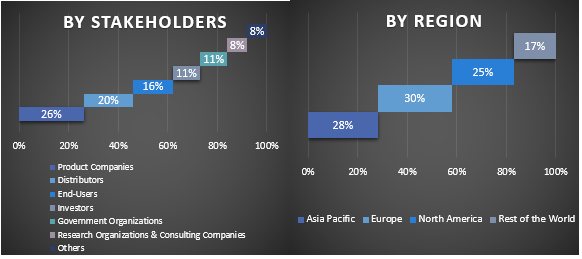


Reviews
There are no reviews yet.